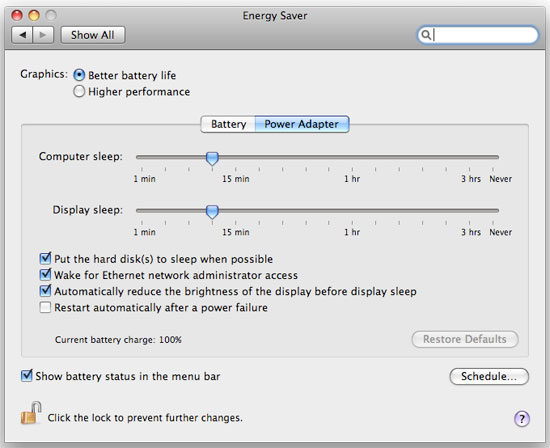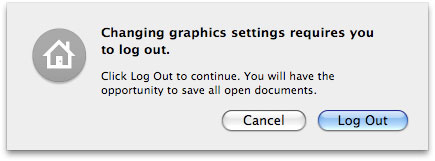Apple's Redesigned MacBook and MacBook Pro: Thoroughly Reviewed
by Anand Lal Shimpi on October 22, 2008 12:00 AM EST- Posted in
- Mac
Two GPUs
While the MacBook relies on the integrated GeForce 9400M, the MacBook Pro includes a discrete GPU as well (NVIDIA calls this a dGPU and the integrated one the mGPU): a GeForce 9600M. The 9600M features 32 SPs up from 16 in the 9400M, giving it more shader power and it's got its own dedicated frame buffer off of a 128-bit memory bus. The dedicated frame buffer is quite possibly the most important but the usefulness here is pretty much limited to games (which are mostly going to be Windows-only) and the high end professional applications that are GPU accelerated.

Apple gives you the option of switching between the two GPUs in the Energy Saver preference pane; unfortunately you have to log out and log back in to switch between the dGPU and mGPU. Other PC implementations of Hybrid Power (what NVIDIA calls the ability to turn off the dGPU and rely on just the mGPU) aren't so clumsy and can be done from within Windows, but for whatever reason Apple requires a logout/login.

The mGPU is preferable for battery life as you'll see in the section on battery life shortly.
Pulling an Apple out of a Hat: DisplayPort Standard
Apple has a tendency of doing this thing where it adopts new standards and gets rid of old ones well before their time is up. It's admirable and it allows Apple to pull off some neat tricks, but as Apple is a much larger manufacturer today than it was in the past we're starting to see examples of why companies like Dell don't take a similar approach.
Case in point is the video output on these two notebooks we're looking at today. Apple had a DVI output on its MacBook Pro but the connector itself was a little too big for the form factor changes that Apple wanted to implement. On the MacBook Air Apple used a mini DVI output, but on the new MacBook and MacBook Pro we have a mini DisplayPort connector.

The mini DisplayPort connector is to the left of the mic-input
Unfortunately only Apple uses mini DisplayPort on its recently introduced 24" display; Dell still uses the full sized DisplayPort connector on its monitors - not to mention the many more that use standard DVI or VGA.
Apple's solution is to offer mini-DP to DVI, DVI, or DL-DVI adapters, which is acceptable; unfortunately neither notebook ships with a single adapter. In the long term this will hopefully be a non-issue, but until then be prepared to spend another $30 or $100 (dual-link DVI) to support an external display.










66 Comments
View All Comments
plonk420 - Thursday, October 23, 2008 - link
could anyone test this with the new (and even old) Mac Book Pro to test for CPU usage?http://www.megaupload.com/?d=ADFYX083">http://www.megaupload.com/?d=ADFYX083
h.264 high profile (QT supports this now, right?) level 4.1 720p60, fairlight/the black lotus's demo Only One Wish (2nd place at Intel's second demo compo) .. has some really handsome bitrate spikes :D ~mid 20s mbps spikes (but not as good as the 60mbit spikes in a 6 or 8mbit (average) encode of ASD's Antisize Matters)
michaelheath - Thursday, October 23, 2008 - link
Having spoken to a few Apple developers I know, the reason for this oddity is Nvidia's software implementation for Mac OS 10.5. While the ideal situation was for them to be able to switch on the fly, the agreement between Apple and Nvidia to develop for the new MacBooks and MacBook Pros happened so quickly it left little time to create a proper application that would allow for this (think of how you had to restart your computer to turn SLI on or off: same slapdash type of programming).The hope is that quick-toggling between integrated and dedicated graphics will come with Mac OS 10.6 as it may be too large of an update to patch Mac OS 10.5. It also makes sense in this aspect as Mac OS 10.6 also includes OpenCL GPGPU algorithms, which Nvidia is already promoting and developing under their CUDA platform.
RDO CA - Thursday, October 23, 2008 - link
On my Thinkpad T-400 with switchable graphics all that is needed to switch is to go to the taskbar icon and click switchable graphics and choose what you want and the screen goes dark for a second and thats it.cliffa3 - Thursday, October 23, 2008 - link
I'll test it sometime this week, but on my Lenovo T61 it seems like I get much more life out of Ubuntu than I do Vista 64-bit. Could be a windows thing in general, not just something that OS X does better.How was the battery life comparison between XP and Vista?
PilgrimShadow - Thursday, October 23, 2008 - link
Anyone know if the 9400M and 9600M appear in Vista's Device Manager?TallCoolOne - Thursday, October 23, 2008 - link
I bought the new 2.0GHz MacBook last week as my first Mac and can say I'm not disappointed. The whole chassis feels as solid as, well, a block of aluminum! As Anand said, it feels like you get what you paid for. I actually like the multi-touch gestures, such as swiping with 3 fingers to flip pages and for back/forward when web browsing. I'd like to see iTunes also support that gesture. Two finger scolling is another great feature not mentioned in this article. What I don't like though is the stiffness of the mouse click. It takes far more pressure than any mouse and that required pressure is uneven in different areas of the trackpad. Pressing near the top requires more pressure than near the bottom. As for lack of standard SSD, Anand, perhaps you're a little too spoiled by that speed! I would not expect that as standard on even the fastest MacBook Pro at current prices. That is, unless you'd like to see the asking price for a MBP $500-600 more than it is now.vlado08 - Thursday, October 23, 2008 - link
It is interesting was vista side panel running during the test. Also was this fresh install of vista os. If it was fresh then was the indeing enabled.vlado08 - Thursday, October 23, 2008 - link
edit indeing - indexingjmpt2 - Thursday, October 23, 2008 - link
Very interesting to read your conclusions about better power management in MacOS vs Vista. This matches my experiences running Vista on the BootCamp partition of my Core Duo MacBook, and is the first time I've seen this discussed anywhere on the web. I found that with a main battery in quite poor condition after two years constant use, it became impossible to use Vista on battery power for more than a minute without the battery deciding it was empty and putting the machine into sleep mode. Under MacOSX the system could still be used for 30min+ (light use) before the same thing happened.I'd come to the conclusion that Apple were deliberately playing games with the ACPI tables to confuse Vista's power management code and make their own OS look better. This seemed to be supported by the fact that Vista is unable to correctly detect the charging state on my MacBook - running on battery power it would always report "Connected to mains, not charging". Does it still work that way on the latest MacBooks? In any case, your data does seems to suggest the problem is a more general issue with Vista. Sounds like you should investigate further...
BZDTemp - Thursday, October 23, 2008 - link
I wonder if OS X lasting longer on a battery can be transfered to the world of none portable?In other words say I run OS X on my daily, none laptop, work machine doing surfing, writing and perhaps listening to music(FLAC prefered over MP3) or even watching an episode of The Daily Show. Will this draw less power from the wall with a PC running OS X than with the same machine running Windows (and is there a difference between Windows versions). Also Linux should be included in the test.
Imagine the perspective - with the whole green computing movement this could really make a difference not just in the server rooms.
Please do check this out - this is not only interesting for us geeks but could make Anandtech something referred to by none-tech news media.